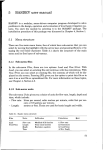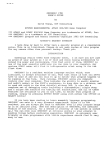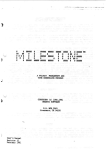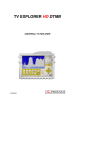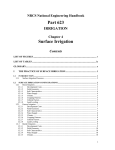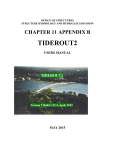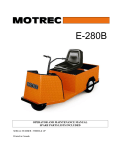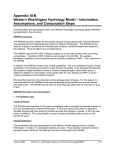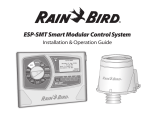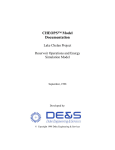Download 6 BORDEV user manual
Transcript
6 BORDEV user manual BORDEV is a modular, menu-driven computer program developed to solve problems in the design, operation, and evaluation of sloping border irrigation systems. You start the module BORDEV by selecting it in the SURDEV package. The installation procedure of this package was discussed in Chapter 4, Section 1. 1 6.1 Menu structure There are six main menu items, five of which have sub-menus that you can select by moving the highlight with the arrow keys and pressing [Enter], or by typing the red (bold) character. Table 6.1 shows the structure of the main menu and its first layer of sub-menus. 6.1.1 Sub-menu files The sub-menu Files gives you two options: Load and View /Print. With Load, you can select an existing file and continue with the calculations. With ViewlPrint you can select an existing file, the contents of which will subsequently be displayed on the screen. Pressing [F5] gives you the option of sending the contents of this file to a printer, a text file, or a spreadsheet file. For more information on these topics, see Chapter 4,Section 4.3. 6.1.2 Sub-menu operation In the sub-menu Operation, you can select the appropriate system operation mode. If you select Fixed flow it means that a constant inlet flow rate will be used to irrigate the borders during the entire application time. Selecting Cutback flow means that, at the end of advance, the inflow is reduced for the remainder of the application time. Selecting Tailwater reuse refers to a border Table 6.1 Bordev menu structure Files Operation Load Fixed flow ViewPrint Cutback flow Tailwater reuse Units Infiltration Calculation Flow rate Length Depth Time Modified SCS families 1. Flow rate Kostiakov-Lewis equation 2. Length 3. Cutoff time 4. Min. Depth Quit 67 irrigation system with a runoff reuse arrangement. Because BORDEV only simulates the flow in one border, the reuse component is not integrated in the required flow rate of another border. The default operation mode is Fixed flow. 6.1.3 Sub-menu units The sub-menu Units is where you can choose pre-determined units for flow rate, length, depth and time. The following units are available: - Flow rate: Litres per second, US gallons per minute, cubic metres per minute, or cubic feet per minute. - Length: Metres or feet, used for border length and width. - Depth: Millimetres or inches, used for the various supplied and infiltrated depths. - Time: Minutes or hours, used not only for advance, cutoff, depletion and recession time, but also for the infiltration equations. The selected units are maintained throughout the program and are also saved with the file. When the program is started, default units are: litres per second for flow rate; metres for border dimensions; millimetres for infiltrated depths; and minutes for time. 6.1.4 Sub-menu infiltration In the sub-menu Infiltration, you can select one of two different infiltration input modes. Both modes are based on the infiltration characteristics of a soil as described by the Kostiakov-Lewis equation (Equation 3.4): Di = kTA + foT where Di is the cumulative infiltration after an infiltration opportunity time T, k is the infiltration constant, A is the infiltration exponent, and f, is the basic infiltration rate. In BORDEV, you can enter the soil infiltration characteristics A, k, and f, directly or indirectly by using the modified SCS families. For more background information on this subject, see Chapter 3, Section 1.1. The default infiltration input mode is the Modified SCS families. 6.1.5 Sub-menu calculation Before actual data can be entered and calculations can be made, you have to select one of the four modes in the sub-menu Calculation (Table 6.1). What the first three modes have in common is that the calculated minimum infiltrated 68 depth at the downstream end of the border always equals the required depth. In other words, no under-irrigation will occur at the downstream end, whereas over-irrigation always occurs in the upstream part. When to use the various modes is summarised below. Calculation Mode 1: Flow rate Calculation Mode 1is primarily for design purposes, when you know the border dimensions and want to know the approximate flow rate that is needed to achieve a reasonable performance. The program will also give you the required cutoff time and the primary performance indicators as well as various depth and time parameters. For the operation modes Fixed flow and Tailwater reuse, BORDEV calculates the flow rate in such a way that the application efficiency is approximately maximised. For the operation mode Cutback flow, the flow rate is determined so that the user-specified advance ratio is achieved. Although the result obtained in this mode is usually close to these targets, it is nevertheless required that you continue running in Modes 3 and/or 4, because in most cases small refinements are still possible. Calculation Mode 2: Dimensions Calculation Mode 2 is the reverse of Calculation Mode 1:the flow rate is now known and you want to know the approximate border dimensions that are needed to achieve a reasonable performance. The program will also give you the required cutoff time and the primary performance indicators as well as various depth and time parameters. In this Mode, the user is required to give the lengthlwidth ratio a figure. The maximum application efficiency is approximate and to get a final result you must continue in Modes 3 and/or 4. Calculation Mode 3: Cutoff time Calculation Mode 3 is one of the two main modes of BORDEV. It will be the one most frequently used and will also be the starting mode for the experienced user. Here, both the flow rate and border dimensions are input. The required cutoff time is the resulting design variable, while the application efficiency and other secondary output are also given. Note, in this mode, the advance ratio is an output, because it is not possible to fix advance ratio, border dimensions and flow rate and, at the same time, satisfy the requirement that the minimum infiltrated depth equals the required depth. Calculation Mode 4: Minimum Depth This is the other main mode of the program. The cutoff time, border dimensions and flow rate are specified as input. Thus, all design variables are input, which means that the required depth at the end of the field will usually not be achieved (ie, that under and/or over-irrigation can occur). The minimum infiltrated depth that occurs at the far end of the field is the main item that deter69 mines whether there is under or over-irrigation. It is therefore given as first output, together with the primary performance indicators: application efficiency, storage efficiency and distribution uniformity. This mode is most suitable for performance evaluation of an existing border irrigation system and for testing the performance sensitivity to a change in the field parameters. 6.2 Input windows After you have selected a calculation mode, BORDEV will display the input screen for data entry: Field Parameters and Input Decision Variables. The input data to be provided in the two windows are summarised in Table 6.2. 6.2.1 Field parameters Infiltration Upon selection of the Modified SCS families type of infiltration data, BORDEV will use it for borders, as was discussed in Chapter 3, Section 1.1. One of seventeen families can be chosen. If a wrong number is typed, an error message with a list of acceptable numbers is shown. To select a particular family, you can use the Help screen by pressing [Fl] while the cursor is on the family number. A screen with the possible numbers will pop up from which you can make your selection (Figure 6.1). Table 6.2 Input variables for the Bordev calculation modes Item Field Parameters Infiltration Required depth Flow resist. Slope Input Decision Variables Inlet flow rate Lengtwwidth ratio Border length Border width ~ k t o f time f Advance ratio Cutback ratio Tailwater recovery ratio 70 Fixed flow Cutback flow Tailwater reuse Mode Mode Mode 1 2 3 4 1 O 0 0 0 O O 0 0 0 O O 0 0 0 O O 0 0 0 O O 0 0 O O 2 3 4 1 0 0 o o O 0 0 0 0 o O 0 0 0 0 0 o O 0 0 0 0 0 o O 0 0 0 0 o O 0 O 2 3 O 4 0 O O O 0 O O 0 O O 0 O O 0 O O 0 O O 0 0 0 O O O 0 O 0 0 o O 0 erosion.is not a problem, except possibly at the head, where water velocity depends on the way in which the total inflow is supplied to the field (pointinlet, type of inlet structure, head ditch, siphons). 6.2.2 Decision variables Decision variables in surface irrigation are normally the field dimensions (length and width), flow rate, and cutoff time. Which of these parameters appear under the heading Input Decision Variables depends on the calculation mode you have selected (see Table 6.2). Border dimensions In Modes 1 , 3 and 4 you can prescribe values for the border length and width. For open-ended borders, an optimum length applies. A field that is too long -will result in a low performance because of a long advance time, with consequently an uneven infiltration and high deep percolation losses. On the other hand, a field that is too short would result in surface runoff that is too high. Consequently, for open-end borders, the optimum length (with all other variables given) is where the sum of deep percolation and surface runoff losses is at its minimum and hence the application efficiency is at its maximum. Length 1width ratio In Mode 2, the lengtwwidth ratio is required to allow the program to calculate the border dimensions, based on a given flow rate. Flow rate In Modes 2, 3 and 4 you can assign values to the total flow rate available for the field. In BORDEV, this inflow rate is divided by the field width to obtain a unit flow rate per metre width, which is used in the numerical simulations. The flow rate should not be too low, otherwise the flow would not reach the end of the border. It should also not be too high, to avoid excessive runoff. Thus, with open-end borders, there is an optimum flow rate (similar to the optimum border length), whereby the sum of deep percolation losses and surface runoff losses is at its minimum, meaning a maximum application efficiency. Cutoff time In Modes 1 , 2 and 3, the cutoff time is a result of the calculations. In Mode 4, a user-specified value can be given. For all three irrigation methods, cutoff is usually done some time after the end of advance, so that the required depth can infiltrate at the downstream end. When the cutoff time is substantially later than advance time, it will have a clear effect on recession, and thus on deep percolation and surface runoff losses. When cutoff is too early, the required depth at the end of the field may not be achieved. 72 Advance ratio The advance ratio, defined as the ratio of advance time to cutoff time, is especially of interest in cutback operation, where it can be either input or output, depending on the purpose (Mode) of the simulation. Cutback ratio The cutback ratio must be specified in all calculation modes during a cutback operation. It is defined as the ratio of the reduced flow rate to the initial flow rate, such that the reduced flow is sufficient to keep the entire field length wetted as long as is necessary, while at the same time reducing the surface runoff. Because of the calculation algorithm used, cutback is assumed to be done when the water has reached the end of the field. Tailwater reuse ratio The tailwater reuse ratio must be specified in all calculation modes for a reuse operation. It is defined as that part of the surface runoff that is reused and applied directly to calculate the application efficiency. A ratio of 1 would be ideal but may not always be possible, particularly because of high costs of the reuse system. 6.2.3 Input ranges Ranges have been fixed for all input variables as shown in Table 6.3 and are in metric units. If other units are chosen in the menu, the indicated ranges are converted in the program. Table 6.3 Accepted ranges of input parameters Input parameters Field Parameters Intake family # Infiltration coefficient, k Infiltration exponent, A Infiltration constant, f, Required depth, D,, Flow resistance, n Field slope Input Decision Variables Border length, L Border width, W Lengthlwidth ratio, LIW Flow rate, Q Cutback ratio Advance ratio Tailwater reuse ratio Cutoff time, T,, Accepted values 0.05 - 2.0 0.05 - 50 “/minA 0.01 - 0.8 0.005 - 30 33 - 250 mm 0.01 - 0.40 0.0005 - 0.05 m/m 50 - 500 m 1- 200 m 1 - 30 1- 250 US 0.65 - 1.00 0.1 - 0.9 0.1 - 1.0 10 - 2000 min 73 Based on a large number of runs, the ranges have been fixed in a bid to avoid too many impossible combinations and corresponding error messages. For all practical purposes, the ranges of the individual parameters will be more than sufficient. If you combine extreme values of the individual parameters you may not get a result. In that case, BORDEV will flash you a message on the screen indicating how to change these values in order to get a result. The above ranges are ignored for output results, so, no warning will be given if such an out-of-range value is subsequently used as input in another mode. 6.3 Output Windows When you have keyed in all the data, press [F2] for the calculations and the output. The screen again shows the two input windows, but a third window has now been added, showing the results (Figure 6.2). These results are presented in various groups, separated by a blank line. The first group contains the desired variable or variables according to the calculation mode you have selected: in Mode 1they are the flow rate and the cutoff time; in Mode 2 the border length, the border width and the cutoff time; in Mode 3 the cutoff time; and in Mode 4 the minimum infiltrated depth. The second group contains the primary performance indicators as discussed in Chapter 3, Section 3. All the calculation modes allow the performance of an irrigation scenario to be evaluated with the application efficiency, surface runoff ratio, deep percolation ratio, distribution uniformity and uniformity coefficient; Mode 4 adds the storage efficiency. Finally, using [PgDnl, you deq". depth Flow resist. 0.15 - Border l e n g t h = Border w i d t h 150 m 20 m OUTPUT, Fixed f l o w , Mode 3 c u t - o f f time Figure 6.2 .74 Bordev output example = 232 min AppliC. e f f i c i e n c y = surf. run-off r a t i o = Deep perc. r a t i o = 65 % Distr. uniformity unif. coefficient = 84 % = 94 % 23 % 13 % obtain two groups with secondary output variables: times and depths. Outputs in all calculation modes are advance time, depletion time, recession time and intake opportunity time corresponding to the downstream point. In all the calculation modes, BORDEV provides information on the maximum, minimum and average infiltrated amounts, together with the amount of surface runoff. In addition, Mode 4 also presents the amount of overhnderirrigation as the average amount over that part of the border that received deficit/excess irrigation. The output also includes the length of the border segment over which deficit and/or excess irrigation occurs. The output results shown are dependent on the combination of Operation and Calculation modes. For the operation mode Fixed flow and Tailwater reuse, the output results of the various calculation modes are shown in Table 6.4on the screen. For the operation mode Cutback flow,however, the cutback flow rate is added to the design variables for all calculation modes, while in Modes 3 and 4 the advance ratio is also added to this category, Table 6.4 Output results for the Bordev calculation modes (Fixed flow system) Output parameters Design variables Border length Border width Flow rate Cutoff time Minimum infiltrated depth Primary performance indicators Application efficiency Surface runoff ratio Deep percolation ratio Storage efficiency Distribution uniformity Uniformity coefficient Time variables Advance time Depletion time Recession time Intake opportunity time Infiltrated depths Maximum infiltrated depth Minimum infiltrated depth Average infiltrated depth Surface runoff Over-irrigation Under-irrigation Length of over-irrigation Length of under-irrigation Mode 1 Mode 2 Mode 3 Mode 4 O O O O O O O O O O O O O O O O O O O O O O O O O O O O O O O O O O O O O O O O O O O O O O O O O O O O O O O O O O O O O O O 75 113 Figure 6.3 225 338 distance (m) 450 Graphical output of Bordev showing advance and recession curves and infiltration profile By pressing the key [F31 you will see two graphs on your screen with the main results; the upper one shows advance and recession time in relation to border distance, while the lower one shows infiltrated depths along the border length. Note, that it is the recession curve that is depicted as with FURDEV, and not the cutoff time as with BASDEV. Under and over-irrigation are indicated, where applicable. This graph can be saved with [F81 or [F91. Figure 6.3 shows the results of Run 3 of Example 1(see Section 6.7.1 and Table 6.5). The tabulated simulation results can be saved together with the input data, with [F41. In a small window, the path (folder + file name) can be confirmed or changed, as described in Section 4.3.3. You can overwrite the previous file or append the current results to it. Further processing of the saved results file must be done under the Files menu, using View /Print (see Chapter 4, Section 4). 6.4 Error messages BORDEV usually gives an output as a result of the calculations. Nevertheless, some variable and parameter combinations - mostly physically unrealistic combinations - could cause mathematical problems. When such problems are encountered, the program will terminate the calculation process and flash a message on the screen, typically containing two layers of information: the nature of the problem and suggestions on how to remedy it. Possible problems can be grouped into three categories: general advance time problems; advance time problems only related to the cutback system; and cutoff time problems. 76 General advance time problems This type of problem can occur with all three operation systems if the advancing front is unable to reach the downstream end of the border. Depending on the calculation mode, BORDEV will suggest increasing the flow rate and/or decreasing the length of the border to overcome the problem. I I Advance time problem with cutback system In Calculation Modes 1and 2, BORDEV calculates the required advance time as a function of the user-specified advance ratio and the required intake opportunity time. You can satisfy the advance time requirement by selecting an appropriate value of the flow rate in Mode 1or that of the border length in Mode 2. In Calculation Mode 1,the advance time associated with the maximum nonerosive flow rate can be longer than the required advance time. Here, the required advance time cannot be realised without using a flow rate that is greater than the maximum non-erosive one. This is clearly unacceptable. The only way out of this problem is to reduce the border length and/or increase the advance ratio. In addition, there are cases in which the flow rate that corresponds to the required advance time is shorter than the minimum flow rate required to advance to the downstream end of the border. When this happens, BORDEV will advise you to increase the border length and/or the advance ratio. In Calculation Mode 2 - with some parameter and variable combinations the required advance time could be greater than the advance time, corresponding to the maximum length to which the user-specified flow rate can advance. To overcome this difficulty, BORDEV will advise you to increase the flow rate and/or decrease the advance ratio. Cutoff time problem In Calculation Modes 1 , 2 and 3, the cutoff time is calculated so that the minimum infiltrated depth is equal to the required depth. In Mode 4,cutoff time is an input. If the user-specified cutoff time is too short, the calculated advance time could exceed it. This is a situation that cannot be handled by BORDEV. When such a problem is encountered, the screen message will recommend decreasing the border length and/or increasing the flow rate, and/or increasing the cutoff time. 6.5 Assumptions and limitations The BORDEV program is based on the volume balance method, which is explained in detail in Appendix B. This method simulates the propagation of the wetting front along a unit width border strip during the advance phase. The ponding, depletion and recession phases are simulated using algebraic approaches. Some implicit assumptions used in the model are: 77 - - - The bed slope is greater than zero. The cutoff time is always greater than the advance time. This limitation is introduced to make sure that advance and recession do not occur simultaneously, a situation that the volume balance model cannot handle. The cross-sectional area of flow at the inlet of the border can be described by Manning's equation. The water depth is limited according to the unit width to ensure steady inflow. The infiltration can be described by the modified Kostiakov infiltration function. The upper boundary of the inflow is the maximum non-erosive flow rate, which can be calculated following the approach of Hart et al. (1980). The minimum flow rate is determined on advance considerations or the flow required for adequate spread, whichever is greater (Hart et al. 1980). More detailed assumptions involved, particularly for the depletion and recession phases, are discussed in Appendix B. Apart from these theoretical assumptions related to the algorithms used, there are a number of more practical assumptions, which could be seen as limitations. The most important are: - The flow rate is constant during the entire application period (unless cutback operation is applied). - The conditions at the inlet enable the water to spread evenly over the entire width of the border strip. - The bed slope is uniform along the border, and the cross slope is zero. - The soil is homogeneous throughout the length of run of the border. - The roughness coefficient is constant. Finally it is assumed that the border is free draining at the end. The program cannot calculate the advance and recession curve for closed-end conditions, or for conditions where runoff water is collected to irrigate a flat extension at the end of the border. To reduce losses, and in particular runoff losses, the program offers the possibility of running the operation modes Cutback flow and Tailwater reuse. The program does not compute how the runoff water reenters the system, which is controlled by local conditions. In the Tailwater reuse mode, a certain fraction of the runoff water specified by the user is assumed to be reused within the same border. In the Cutback mode, the assumption is that when water reaches the end of the border strip, the inflow is reduced to a value less than the inflow rate during the advance phase. The flow rate is constant before and after cutback. The applicability of the BORDEV program is therefore bound by conditions that satisfy the assumptions stated above. Nevertheless, the simulation results with BORDEV will be in line with field observations, provided that the field conditions match the above-mentioned practical assumptions. As stated in the other programs, the BORDEV program only deals with the technical 78 and hydraulic aspects of border irrigation. The program should therefore be regarded as an aid in the design, operation and evaluation. Final decisions in the field will be controlled findings of the program in conjunction with agricultural, economic and social considerations. 6.6 Program usage The following nine steps are important in the usage of the BORDEV program. 1. Start the SURDEV package. Select BORDEV from the main menu of SURDEV. 2. If you want to use an existing file, retrieve it with the Load command under the Files menu. If you want to make a completely new file, go straight to the Calculation menu, bypassing the Files menu and you will get a set of default data. 3. If you want to simulate cutback flow or reuse, go to the Operation menu and select the operation mode to work with. The program default operation mode is Fixed Inflow. 4. Select the Units menu only when you want to work with units other than the default units. 5. The default infiltration mode is the Modified SCS Families. If you prefer to work with another infiltration mode, go to the Infiltration menu. 6. Select a mode from the Calculation menu. Most work will be done in Modes 3 and/or 4. Less experienced users can start in Mode 1 or 2 to get a first estimate of the flow rate or field dimensions, respectively. Mode 4 can be used to evaluate existing situations or to do sensitivity analyses. 7. In the input window, Field parameters and Decision variables can be specified, after which the program can be run with [F2]. 8. You can view the results of each run in tabular form in the output window, or in graphical form using [F31. The results of one simulation run (output and input in one file) can be saved in a separate file or can be appended to earlier runs in an existing file with [F4]. 9. Select Files and View JPrint from the main menu to see what has been done and/or to print a file directly, or convert it to a print file for a word-processor program, or convert it to a file to be imported in a spreadsheet program where you can make your own graphs. 6.7 Sample problems In most cases, the user will not be satisfied with a solution obtained after one run, and will usually do a number of runs to get an acceptable solution. Two simple examples are given to illustrate this procedure. For more elaborate problems, see Chapter 8, Section 2. 79 6.7.1 Fixed flow system An operation practice is to be Ldvelopec for a fixec flow border irrigation system. The field in which the system is to be installed is 450 m long in the direction of the main slope. The individual borders are 20 m wide. The soil is silty loam and can be classified by the intake family # 0.5. The net irrigation requirement is 100 mm. Other input values are default. The flow rate is to be determined in such a way that the application efficiency is at least 70 per cent and the cutoff time has a practical value. 1. We want to make a new file, and therefore do not need to use the Files submenu. Note, the operation, units and parameter modes and values to be used in this example are the default ones, so we can go directly to the Calculation menu and select Mode 1: Flow Rate. Enter the above values in the two input windows and make a run. 2. The results of this run (Table 6.5, Run 1)show that at a rate of 47 V s , a border of 450 m long and 20 m wide can be irrigated with an application efficiency of 66 per cent. The corresponding uniformity coefficient is 91 per cent and the distribution uniformity is 78 per cent. This application efficiency is too low. Increase the flow rate to 50 V s and run BORDEV in Mode 3 and observe the effect. 3. This run (Table 6.5, Run 2) reveals the application efficiency to be the same as before, which is still below the target efficiency. The cutoff time decreased from 485 to 457 minutes, but is still an impractical value. Next we make a run in Mode 4 to see the effect when the cutoff time is reduced from 457 to 420 minutes (7 hours); 4. With this run (Table 6.5, Run 3) the reduced cutoff time results in an application efficiency of 71 per cent, which is acceptable. The corresponding uniformity coefficient is 91 per cent and the distribution uniformity is 78 per cent. But, the consequence of reducing the cutoff time is also a slight under-irrigation: the minimum infiltrated depth is now 92 mm instead of 100 mm. Over the lower 56 m of the border, the average depth infiltrated would be 4 mm less than that required. The upper 394 m of the border would receive an over-irrigation of 20 mm. These results are acceptable. Table 6.5 can be made with BORDEV. The procedure is as follows. Save Run 1 with [F41 and prescribe a particular file name (EXAMPLE1). BORDEV automatically adds the extension .BDR to this file name. Save Runs 2 and 3 with [F41 under the same file name using the Append option. Go back to the main menu, go to Files menu, select Print/View, then EXAMPLEl. See the results and select [F5] (PrintlSaue) and then the option Text file. BORDEV now automatically adds the extension .TXT to the file name EXAMPLE1. If you now go out of BORDEV, you can load the results in a word-processing program by retrieving the file EXAMPLE1.TXT. This is how you make Table 6.5. 80 Table 6.5 Bordev program for sloping border irrigation (Filename: EXAMPLE1) Run no. Type of system Calculation Mode Input Parameters Flow rate Length Width Cutoff time Required depth Flow resistance Bed slope Intake family Output Parameters Flow rate Cutoff time Application eff. Storage eff. Uniform. coeff. Distrib. unif. Deep perc. ratio Runoff ratio Avg. inf. depth Max. inf. Depth Min. inf. depth Surface runoff Over-irrigation Under-irrigation Over-irr. Length Under-irr. Length Advance time Depletion time Recession time Opportunity time 1 1 1 2 1 3 3 1 4 WS - m m min mm m/m - 450 20 50 450 20 - - 100 0.15 0.008 0.5 100 0.15 0.008 0.5 50 450 20 420 100 0.15 0.008 0.5 47.02 485 66 100 91 78 19 15 128 142 100 23 28 O 450 O 287 542 627 339 - Units ws min % % % % % % mm mm mm mm mm mm m m min min min min 457 66 100 92 80 16 18 125 137 100 28 25 O 450 O 260 514 599 339 71 99 91 78 13 16 117 129 92 23 20 4 394 56 260 476 560 300 The above problem concerned the Fixed flow operation mode. For the same situation as described above, BORDEV will now be used in the design of a Cutback flow operation mode. 6.7.2 Cutback flow system This sample problem is presented to illustrate how the irrigation performance under the fixed flow system of Section 6.7.1 can be improved by switching to the cutback flow system. 81 1. Go to the Operations menu and select Cutback flow. Go to the Calculation menu and select Mode 1:Flow rate. Enter the same values in the two input windows as in Table 6.5 and make a run. Keep the default Advance Ratio at 0.33 and the default Cutback Ratio at 0.65. 2. The results of this run (Table 6.6, Run 1)show that at a flow rate of 69 I/s, a border 450 m long and 20 m wide can be irrigated with an application efficiency of 73 per cent. Once the water has reached the end of the border, the flow rate is reduced to 45 Vs. A cutoff time of 366 minutes is required. Table 6.6 Bordev program for sloping border irrigation (Filename: EXAMPLE21 Run no. Type of system Calculation Mode Input Parameters Flow rate Length Width Cutoff time Advance ratio Cutback ratio Required depth Flow resistance Bed slope Intake family Output Parameters Flow rate Cutback flow Cutoff time Cutback time Advance ratio Application eff. Storage eff. Uniformity coeff. Distrib. unif. Deep perc. ratio Runoff ratio Avg. inf. Depth Max. inf. depth Min. inf. depth Surface runoff Over-irrigation Under-irrigation Over-irr. Length Under-irr. Length Advance time Depletion time Recession time Opportunity time 82 Units US m m min mm m/m - US US min min % % % % % % mm mm mm mm mm mm m m min min min min 1 2 1 2 2 3 3 2 4 450 20 0.33 0.65 100 0.15 0.008 0.5 70 450 20 0.65 100 0.15 0.008 0.5 70 450 20 300 69.1 44.92 366 167 73 100 95 88 13 14 113 119 100 23 13 O 450 O 167 425 506 339 - 45.5 364 164 0.45 73 100 95 89 13 14 113 119 100 24 13 O 450 O 164 422 504 339 - 0.65 100 0.15 0.008 0.5 45.5 164 0.55 82 97 94 86 4 13 99 106 86 18 4 6 244 206 164 358 437 272 The corresponding uniformity coefficient is 95 per cent and the distribution uniformity 88 per cent. We run BORDEV in Mode 3 to see the effect when the flow rate is increased to a practical value of 70 Vs. 3. The outcome of this run (Table 6.6, Run 2) show that the application efficiency and the cutoff time remain practically the same (because of the slight difference in flow rate). The cutoff time, however, has an impractical value. Now go to Mode 4 to see the effect when this is reduced from 364 to 300 minutes. 4. This run (Table 6.6, Run 3) shows hat this reduction in cutoff time results in an application efficiency of 82 per cent. The corresponding uniformity coefficient is 94 per cent and the distribution uniformity is 86 per cent. Obviously, the reduced cutoff time also results in some under-irrigation: the minimum infiltrated depth is now 86 mm instead of 100 mm. Over the lower 206 m of the border, the average depth infiltrated would be 6 mm less than that required. The upper 244 m of the border would receive an overirrigation of 4 mm. These results are acceptable. A comparison of Tables 6.5 and 6.6 shows that a cutback flow operation mode can increase the application efficiency from 7 1 to 82 per cent, which is a considerable improvement. Table 6.6 was also made with BORDEV. Once you are familiar with the foregoing basic elements of working with BORDEV, you can do more elaborate work, examples of which are presented in Chapter 8. These concern several sets of runs with which various relationships can be established. This not only illustrates the potential of the program, but also provides a deeper insight into the complex nature of the border irrigation process. 83


















